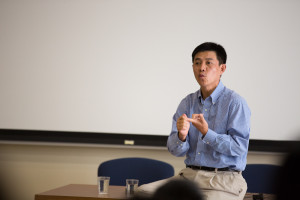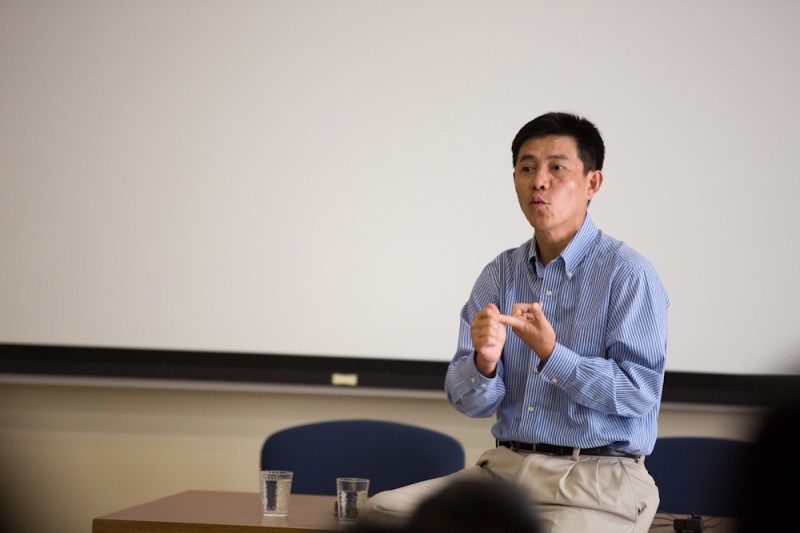The annual Forum for American-Chinese Exchange at Stanford (FACES) summit returned this past weekend after a year of inactivity due to many group members graduating.
The “On Common Ground” (OCG) summit-held on campus from Nov. 7 to 10-brought together 50 students from the United States and Chinese universities to promote trust and understanding between the two countries.
Isabella Fu ’15, co-president of FACES, discussed the value of person-to-person interaction in human relationships, and described the summit as a dynamic environment to facilitate this interaction.

“We are aiming to cultivate future leaders in the U.S. and China,” Fu said. “[OCG is] inspiring young people and helping them understand different perspectives from the other side of the ocean.”
Fu went on to describe the importance of mutual understanding in the bilateral relations between the U.S. and China.
“The people of these countries have a very disheartening misunderstanding of each other,” Fu said. “I think most people would agree that it’s very important for these countries to come together.”
Hao Yi Ong ’14, co-president of FACES, described the summit as a way to form long-term cooperative networks between future U.S. and Chinese leaders, and emphasized that the responsibility to create and maintain those relationships lay in the hands of conference delegates.
“Whatever they get out of [the conference] is really how much they want to put it in terms of networking,” Ong said. “Networking at the level where they’re at and where they’re likely to become future leaders…that’s where the real added value is going to take place.”
Henness Leung, a student from the University of Hong Kong attending the conference, also saw the importance of the face-to-face communication facilitated by the conference.
“The media may be biased, especially in the case of China,” Leung said. “Communication between delegates is the most direct channel to clarify misconceptions.”
This year’s summit speakers included keynote speaker John L. Holden, former president of the National Committee on U.S.-China Relations, and Hans Tung, a Chinese venture capitalist ranked No. 100 on the 2013 Forbes Midas list.
After attending OCG, delegates shared their conference experiences.
Will Yale, a graduate student from the Johns Hopkins University School of Advanced International Studies, described networking as the most important part of the conference.
“[I enjoyed] the socializing-getting to know a lot of well-informed and committed people,” Yale said. “The people and the interaction between students was the most important part of the conference.”
Yi Tao Zhang ’14 M.S. ’14 also shared what he learned in the conference.
“My biggest takeaway…was the role of innovation in elevating China into a First World country,” Zhang said.
Ong described several changes to this year’s OCG conference, the most visible being scheduling.
In order to accommodate schedule conflicts with events like graduations, the Stanford portion of the conference took place during fall instead of spring. The closing summit will be in China in April 2014.
Another major change to OCG this year was an increased involvement of FACES student officers in the conference.
“We’re trying to get our officers to do a lot more,” Ong said. “For example, we have a liaison officer program where we personally attach one officer to one speaker, so they have that personal connection.”
Fu said that the summit did not take place last year due to logistical reasons, since a significant portion of FACES graduated in the Class of 2012.
“We didn’t have a conference last year because all our officers happened to be very young-they were freshmen, sophomores,” Fu said. “It would be hard for us to start a conference only with people who have not gone through it.”
However, Ong said that the yearlong gap between conferences helped FACES to regroup and rethink its strategy, eventually hosting a one-day symposium event last year instead of a conference.
“[The gap year] gave us time to think, look at certain priorities and boost our campus programming,” Ong said. “Having a stronger on-campus presence, partly through our symposium, should continue this year.”
Moving forward, Fu and Ong said that they expect the summit to continue regularly on an annual basis.
“This year we really placed an emphasis on recruiting…Now we have a lot of freshmen,” Fu said. “When we graduate, there will be people who can keep running the conference.”
Fu and Ong said goals for future summits include strengthening the accessibility of the event on campus. Ong discussed efforts to increase the number of Stanford delegates participating in the conference and to reach out to a broader audience.
“My idea is that undergraduates need to know about this [experience] from the very start,” Ong said. “It’s important for undergrads to get on board.”
Ong added that he is confident in the ability of future summits to create greater understanding between the U.S. and China.
“It’s basically the milestone effort of FACES every year,” Ong said. “It may change a little in character, but not in its mission.”
Contact Minkee Kim Sohn at minkees ‘at’ stanford.edu.
